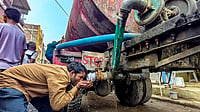Located in a red brick building, in what was once a tobacco warehouse on Lancaster's busy Plum and Walnut Street, LMB turned out to be an industrial-type brewpub. From the overcrowded bar at the entrance, through to the busy dining area leading into a vast open kitchen, the interior was a large hall of exposed brick walls and copper fittings. This overlooked the brewhouse, revealing shining brewing equipment and tall stainless steel fermenters with variously curved pipe attachments. Besides hitting the busiest nightspot, we also turned lucky, as LMB was celebrating its second anniversary, and there was a discount on food and drink.
We jumped at the special offer strawberry wheat beer, a light golden ale, being sold for 50 cents a pint (as against $2.75). The Tabasco oyster shooters in dark LMB Porter beer ordered as chasers were fireballs. A meal of beer and cheese soup, beer battered zucchini and onion rings, beer cheese fondue, each cooked in a different brew was worth every cent. The LMB (Lancaster Malt Brewing Co.) is part of beer history. Brewing in Lancaster Country grew from the backrooms of inns and taverns in the early 1700s, and by 1810 the country accounted for 7 per cent of all beer in the United States. Prohibition was no deterrent. In 1932, a worker discovered a hose in a sewer that ran from a brewery to a warehouse where the brew was discharged into kegs. However, bowing to economic pressure, and the Amish presence I daresay, the last brewery closed down in 1956. LMB has revived a grand tradition associated with the waters of the river Conesta that flows gently through the country.
























